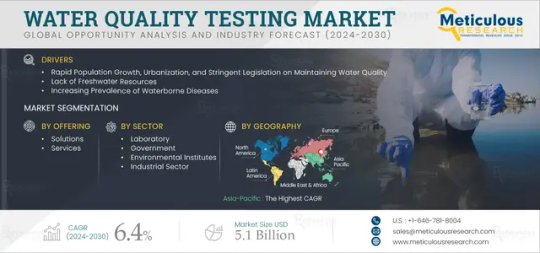#Water Testing and Analysis Market
Explore tagged Tumblr posts
Text
Water Testing and Analysis Market - Forecast(2024 - 2030)
The global water testing and analysis market generated a revenue of $4060.2 million in 2017 and is expected to rise with a CAGR of 6.7% during the forecast period of 2018-2023. Among the different types of tests, the pH test generated the maximum market share of $1400.1 million in 2017 and is projected to rise in the coming years with a CAGR of 7% during forecast year of 2018-2023. Rapid industrialization and growing needs in developing countries has raised the demand for water testing and analysis. Also, the stringent regulations by various government bodies to maintain the water quality is also driving the market growth for water testing and analysis market.
Request Sample
What is Water Testing and Analysis?
Water testing is a process of assessing water quality. Water quality has to be tested regularly to determine the health of water. Water has various properties such as turbidity, dissolved gas content, radioactivity and water conductivity are measured through water testing and analysis. The quality of water is essential to many different industries and activities such as agriculture, fisheries, electronics, food, pharmaceutical aquaculture and forestry. The different types of water tests include physiochemical tests and bacteriological tests. The physiochemical tests are carried out by various methods such as titration, spectrophotometric methods, etc. These tests includes pH test, odor, turbidity test, BOD and TOC, radio activity test and dissolved oxygen test. The bacteriological tests involve the use of membrane filters and multi tube dilution method to determine the total coliforms and fecal coliforms.
What are the applications of Water Testing and Analysis?
Water testing is used in various industries such as mining, refineries, semiconductor, metals, pharmaceutical, food and beverage and several others. Water plays a critical role in pharmaceutical industry and thus has to be free from all the contaminants. The end user industry analysis of water testing and analysis market provides a complete detailed study of the market and the sectors involved in it. Water testing plays a major role in electronics industries as it requires ultrapure water for manufacturing and cleaning.
In electronics industry salinity testing is used to test water, it helps to test the amount of salt in water which will help in generating electricity. Salt diffused water is more efficient for generating electricity hence salinity tester are used to test salinity of water. Mining and refineries utilize large volume of water. The waste water generated from these industries are tested and treated in order to avoid pollution. Water quality is a priority for many industries hence with the growth of such industries is expected to expand the market size of Water testing and analysis industry.
Inquiry Before Buying
Market Research and Market Trends of Water testing and Analysis:
It is known that high concentration of lead in drinking water can cause serious neural disorders. The present method to check the concentration of lead is sending the samples to laboratories equipped with detection technology. This method is expensive and time consuming. Thus, companies are developing a portable device which works along with the smart phone for detection of lead concentration in drinking water. This method will give quick results with high accuracy and low cost.
Due to the advancement in technology, the water testing market is focusing on using AI and machine learning techniques including neural networks and video analytics to detect the optical characteristics of water like color, odor, motion and other contaminants.
Dirty water is a serious health concern as it causes several diseases. In order to mitigate the level of contaminants, researchers are finding ways to filter out the tiniest impurities in water with the use of nano particles. As it is discovered that graphene eliminates the smallest impurities, manufacturers are trying to incorporate gold nano particles along with graphene sensors or films to exclude the contaminants by making the process more efficient.
Water is easily contaminated by arsenic and other metals that leach out of the soil during the mining process. All the current testing methods consume a lot of time to deliver the results. Many companies are focusing on development of low cost test strips to detect the life threatening contaminants in no time. This would help people to monitor the water and take preventive measures.
Schedule a Call
Who are the Major Players in Water Testing and Analysis Market?
The companies referred in the market research report are GE Power & Water, Global Treat, Inc., Horiba Ltd, Shimadzu Corporation, Thermo Fisher Scientific Inc. and 10 other companies.
What is our report scope?
The report incorporates in-depth assessment of the competitive landscape, product market sizing, product benchmarking, market trends, product developments, financial analysis, strategic analysis and so on to gauge the impact forces and potential opportunities of the market. Apart from this the report also includes a study of major developments in the market such as product launches, agreements, acquisitions, collaborations, mergers and so on to comprehend the prevailing market dynamics at present and its impact during the forecast period 2018-2023.
All our reports are customizable to your company needs to a certain extent, we do provide 20 free consulting hours along with purchase of each report, and this will allow you to request any additional data to customize the report to your needs.
Buy Now
Key Takeaways from this Report
Evaluate market potential through analyzing growth rates (CAGR %), Volume (Units) and Value ($M) data given at country level – for product types, end use applications and by different industry verticals.
Understand the different dynamics influencing the market – key driving factors, challenges and hidden opportunities.
Get in-depth insights on your competitor performance – market shares, strategies, financial benchmarking, product benchmarking, SWOT and more.
Analyze the sales and distribution channels across key geographies to improve top-line revenues.
Understand the industry supply chain with a deep-dive on the value augmentation at each step, in order to optimize value and bring efficiencies in your processes.
Get a quick outlook on the market entropy – M&A’s, deals, partnerships, product launches of all key players for the past 4 years.
Evaluate the supply-demand gaps, import-export statistics and regulatory landscape for more than top 20 countries globally for the market.
#Water Testing#Waste Water Treatment#Desalination#Total Organic Carbon#Injection Water#Municipal Water#Drinking Water#Water Testing and Analysis Market#Water Testing and Analysis Market Analysis#Water Testing and Analysis Market Forecast#Water Testing and Analysis Market Growth#Water Testing and Analysis Market Outlook#Water Testing and Analysis Market Research#Water Testing and Analysis Market Revenue#Water Testing and Analysis Market Share#Water Testing and Analysis Market Size
0 notes
Text
Water Testing & Analysis Market Size, Share, Analysis Report 2024-2032

IMARC Group's report titled "Water Testing & Analysis Market Report by Product Type (TOC Analyzer, pH Meter, Dissolved Oxygen Meter, Conductivity Sensor, Turbidity Meter, and Others), Type (Portable, Handheld, Benchtop, and Others), Application (Laboratory, Industrial, Environmental, Government, and Others), and Region 2024-2032", The global water testing & analysis market size reached US$ 5.0 Billion in 2023. Looking forward, IMARC Group expects the market to reach US$ 8.4 Billion by 2032, exhibiting a growth rate (CAGR) of 5.85% during 2024-2032.
For an in-depth analysis, you can refer sample copy of the report: https://www.imarcgroup.com/water-testing-analysis-market/requestsample
Factors Affecting the Growth of the Water Testing and Analysis Industry:
Stringent Environmental Regulations:
Governing agencies of several countries are implementing stringent environmental regulations to mitigate the impact of pollution on water bodies, which is impelling the market growth. Compliance with these standards necessitates thorough monitoring and analysis of water quality by industries and municipalities. Stricter enforcement of regulations compels organizations to invest in advanced testing technologies and services to meet compliance requirements. Apart from this, water testing helps identify pollutants and assess their levels, ensuring that water quality meets regulatory standards. Failure to comply with these regulations can result in hefty fines, legal repercussions, and damage to reputation.
Rising Awareness About Waterborne Diseases:
The escalating demand for water testing and analysis due to the increasing awareness among individuals about the harmful effects of waterborne diseases on their health is propelling the market growth. In addition, the rising need for regular monitoring to prevent health hazards is bolstering the market growth. Consumers are increasingly prioritizing access to clean and safe drinking water. The increasing adoption of water testing solutions on account of changing consumer behavior is supporting the market growth. Furthermore, companies are investing in comprehensive testing infrastructure to reduce the risk of waterborne diseases among the masses and maintain their reputation.
Technological Innovations:
Advancements in water testing and analysis assist in facilitating faster, more accurate, and cost-effective methods. Innovations, such as portable testing devices, automated systems, and sensor technologies, streamline the testing process, making it more accessible to a broader range of users. These advancements not only enhance efficiency but also enable real time monitoring and data analysis, empowering stakeholders to make informed decisions regarding water management. Besides this, these advancements are leading to continuous improvement and innovation in addressing evolving water-related challenges.
Leading Companies Operating in the Global Alternator Industry:
ABB Ltd.
Agilent Technologies Inc.
Danaher Corporation
Horiba Ltd.
PerkinElmer Inc.
Shimadzu Corporation
Thermo Fisher Scientific Inc.
Tintometer GmbH
Water Testing and Analysis Market Report Segmentation:
By Product Type:
TOC Analyzer
pH Meter
Dissolved Oxygen Meter
Conductivity Sensor
Turbidity Meter
Others
pH meter represents the largest segment on account of the rising awareness among individuals about water quality.
By Type:
Portable
Handheld
Benchtop
Others
Portable holds the biggest market share, driven by its convenience, speed, and real time results.
By Application:
Laboratory
Industrial
Environmental
Government
Others
Industrial accounts for the largest market share due to the stringent environmental regulations.
Regional Insights:
North America (United States, Canada)
Asia Pacific (China, Japan, India, South Korea, Australia, Indonesia, Others)
Europe (Germany, France, United Kingdom, Italy, Spain, Russia, Others)
Latin America (Brazil, Mexico, Others)
Middle East and Africa
North America enjoys a leading position in the water testing and analysis market, which can be accredited to the increasing demand for water testing at the residential level.
Global Water Testing and Analysis Market Trends:
The rising level of water pollution due to stemming from industrial discharge, agricultural runoff, and urban development is impelling the market growth. Water testing and analysis are becoming vital to identify contaminants and ensure the safety of water sources. Regulatory bodies are imposing stricter standards, as pollution is threatening aquatic ecosystems and human health. In addition, the increasing focus on safeguarding public health and maintaining environmental sustainability is bolstering the market growth.
Furthermore, pharmaceutical and biotechnology industries require high-quality water for manufacturing processes to meet regulatory standards and ensure product quality.
Note: If you need specific information that is not currently within the scope of the report, we will provide it to you as a part of the customization.
About Us:
IMARC Group is a leading market research company that offers management strategy and market research worldwide. We partner with clients in all sectors and regions to identify their highest-value opportunities, address their most critical challenges, and transform their businesses.
IMARCs information products include major market, scientific, economic and technological developments for business leaders in pharmaceutical, industrial, and high technology organizations. Market forecasts and industry analysis for biotechnology, advanced materials, pharmaceuticals, food and beverage, travel and tourism, nanotechnology and novel processing methods are at the top of the companys expertise.
Our offerings include comprehensive market intelligence in the form of research reports, production cost reports, feasibility studies, and consulting services. Our team, which includes experienced researchers and analysts from various industries, is dedicated to providing high-quality data and insights to our clientele, ranging from small and medium businesses to Fortune 1000 corporations.
Contact Us:
IMARC Group
134 N 4th St. Brooklyn, NY 11249, USA
Email: [email protected]
Tel No:(D) +91 120 433 0800
United States: +1-631-791-1145 | United Kingdom: +44-753-713-2163
0 notes
Note
Do you think the dickkory posts on the social media are simply the interns prefference or DC possibly testing the waters in terms of the ship popularity?
Hmm.. based on my experiences as PR intern working in social media projects, interns' work results have to go through higher ups first, anon. Believe me, interns don't have that much freedom in deciding what to post since it directly involves a company's image. Even if the higher ups in charge approved of the intern's pitch, it had to fit in in the carefully curated content calendar across social media platforms. So, we should rejoice that those dickkory posts were an entire department's decisions, lmao.
It's high in possibility that they did it to test the waters, yes. Based on what i studied, when a company wants to launch something, they tend to do market research first. It could be in the form of surveys, demographic analysis, psychographic analysis, trend analysis, enviromental scanning, etc. It's possible they did the last two using their social media. But again, it's just a possibility. I say let's see the patterns, anon. If they keep posting dickkory for a few more times this year, then something big is definitely coming. Be optimistic, but don't be too sad when turns out it's not what we're expecting, yes?
22 notes
·
View notes
Text
Locally adapted, decentralised innovation is reshaping what environmental monitoring in Africa

Projects like AirQo in Uganda and Clarity Nodes in Nairobi are deploying low-cost particulate matter sensors to create real-time urban air quality maps.
These portable devices, calibrated against reference stations, are not housed in government ministries—they’re installed in schools, markets, and transit corridors.
This hyperlocal, community-focused deployment marks a decisive shift toward monitoring as a distributed public good.
In the water space, compact mobile testing kits—some linked to smartphones—are enabling NGOs and universities to test for E. coli, nitrates, and fluoride in boreholes and streams. These kits don’t require lab infrastructure or formal training, making them ideal for community-led sampling in rural areas.
Remote sensing is also playing a vital role. Satellite data from programs like Sentinel and MODIS is being used to track vegetation loss, algal blooms, and surface water dynamics.
In Lake Victoria, a hybrid approach pairs satellite analysis with on-the-ground sensors—offering a model for blended, multilayered monitoring frameworks that don’t depend on centralised equipment alone.
Perhaps the most transformative development is the rise of citizen science networks.
In Ghana, Nigeria, and Uganda, residents are using hand-held air monitors to document conditions in their own neighbourhoods.
These datasets are often shared via open-access platforms, where they inform city planning and regulatory debates. They also demonstrate a growing confidence in decentralised data ownership and interpretation.
Universities across the continent are enabling much of this innovation. Institutions like the University of Cape Town and Makerere University are not only building and testing sensors but also training local technicians and hosting data platforms. Their work has become a central node in an emerging, distributed monitoring ecosystem.
Source
#solarpunk#solar punk#community#africa#environmental monitoring#citizen science#distributed public goods
19 notes
·
View notes
Text
Donald Trump makes no secret of his loathing for regulations that limit water and energy use by home appliances. For years, he has regaled supporters at his campaign rallies with fanciful stories about their impact. He is so exercised by the issue that, even as global stock markets convulsed Wednesday in response to his tariff plans, Trump took time out to issue an executive order titled “Maintaining Acceptable Water Pressure in Showerheads.”
Contemporary shower fixtures are only one of the items that rankle the president, who complains that “there’s no water coming and you end up standing there five times longer,” making it difficult to coif his “perfect” hair. He has frequently denounced dishwashers that he claims take so long and clean so poorly that “the electric bill is ten times more than the water”; toilets that require flushing “ten or 15 times”; and LED lightbulbs, which he faults for making him look orange.
In his first term, Trump pursued an array of gimmicks to try to undermine the rules. His moves were opposed by industry and environmental groups alike. If it’s possible for regulations to be popular, these ones are. They have cut America’s water and energy consumption, reduced global-warming emissions and saved consumers money. Legal prohibitions stymied most of Trump’s maneuvers back then, and the Biden administration quickly reversed the steps Trump managed to take.
Trump’s executive order on showerheads generated headlines, but it’s likely to have little effect (more on that later). Far more consequential steps have been taken outside the Oval Office.
With the aid of Elon Musk’s Department of Government Efficiency team, Trump appears to be attempting an end run that could succeed where his past attempts failed: by simply terminating the consulting contract that the Department of Energy relies on to develop and enforce the rules. In late March, DOGE’s “wall of receipts” stated that it had “deleted” a Department of Energy contract for Guidehouse LLP (a PricewaterhouseCoopers spinoff) for “Appliance Standards Analysis and Regulatory Support Service,” producing a listed savings of $247,603,000. That item has now disappeared from the DOGE website, and its current status remains unclear.
This has produced confusion for everyone from appliance manufacturers to government officials to the contractors paid to enforce the rules. If the contract is indeed canceled, experts told ProPublica, it would cripple the government’s efficiency standards program, which relies on the consulting firm’s technical expertise and testing labs to update standards, ensure compliance and punish violators.
14 notes
·
View notes
Note
do u have any super awesome reko hcs ?? id like to hear yr thoughts :3
*cracks knuckles*
most of my ideas on her are based on canon, so ive never considered them outlandish enough to call headcanons, but i guess technically pretty much all of my rants about her could be sorted as such, since they try to build on what we already know and extrapolate an analysis. i have too many to list. ill try to compile some here, though. longer ones are under the cut.
i moreso stole this headcanon then made it but i agree that reko cant cook for shit. she lives off takeout and stuff she burnt in the microwave, much to her protective older brother's dismay.
i believe reko was putting on her makeup and styling her hair every morning in chapter 2. again, i stole this one.
i think reko would be really good at video games
reko would be very good at ice skating
despite being good at drawing her eyeliner, i dont think she can draw very well on paper.
reko paints her nails sometimes (she likes the smell) but its always chipped somehow, even if she just painted them.
she doesnt have an extensive (if any) skin care routine (thats more her brothers thing) but she does have a hair care routine after almost frying off all her hair several times trying to bleach it herself. she only dyes her bangs now but she still takes good care of her hair (especially with the way she has to style it everyday).
reko is either out of the bathroom in 2 seconds or she takes an hour because she gets distracted and starts messing with her hair or makeup. it used to drive alice crazy when they both lived with their parents. not now alice, you can go shit in the bushes, reko is using her eyeliner as face paint.
reko tries not to do this when shes working on new songs, but shes the type of person who almost always listening to some kind of music. she loves finding new music and new subgenres.
shes not really a messy person but shes not very neat, either. she usually has trash slowly building up somewhere. nothing 15 minutes of panic cleaning cant fix, but its there.
i think reko made / makes a lot of her own punk clothes and accessories, and generally has frugal habits around her style. it started when she was a teen because her rebelliousness and delinquency led to her being perpetually grounded, so no allowance. shes awful at customer service so she couldnt really get an entry level job. her music wasnt really marketable and she probably didnt have her own band in her younger teens ( i think samurai yaiba was probably only started when she was about to or already graduated high school) so there wasnt much if any income from there. she may have done some odd jobs but they didnt pay much and she was intimidating to people, so it was hard to get gigs. all this led to her getting good at sewing, dying, bleaching and otherwise making her own clothes. probably owns a bunch of pins, studs, and zippers in bulk just to sew onto stuff. i think the same thing applies to her make up- she uses fancier water / sweat proof on stage, but off stage? dollar store eyeliner and foundation. she doesnt care about the risks, she goes through her make up too fast to bother with the fancy stuff.
reko has an impressive memory generally, but when she struggles with it, she makes little songs or rhymes to help her remember (she did this to sometimes help her speed memorize for tests in school. then, she had to whisper-sing it under her breath and swing her foot to the beat and itd be all you could hear in the test room, and shed either get in trouble or just be really embarrassed).
speaking of school, i dont think reko went to college or post secondary school; in ytts theres a whole thing about her hating school. but aside from that, the timing would be really tight. shes canonically 23, samurai yaiba was 2 1/2 years ago, so she wouldve been 20-21, and you graduate high school at 18. i cant say i know a lot about japanese college, but if it has the same status of degrees as in the US, it wouldnt really make sense for her to have gone to college- she was likely a drop out or never went in the first place.
i think reko has some burner account(s) where she dumps experimental music. its not always avant garde, but she likes playing with different genres. the problem is they keep escaping containment, even though shes embarrassed by them and thinks theyre all shit. no one can know about her breakcore album with 6 million views that she made while she was drunk and garage band crashed halfway through so theres weird chunks missing and distorted audio. no one. no one can know about the ska music made. god, not the ska.
reko has theater kid energy to me (both the yabusames do), but i doubt she was ever in any productions. her band/orchestra vibes are stronger and thats probably what she wouldve devoted all her time to instead. maybe, like, one musical, but she mightve not gotten the role she wanted and immediately quit. if she was, she drove everyone up a wall cause she was so hard to work with. shes a natural but she never shows up to any practices and is so easy to piss off, especially during the acting portions. skipping practice isnt a big deal to her because she can memorize things quickly, but it screws all the other actors up. she just isnt a team player (or rather, reko really wasnt a team player in highschool).
reko is a caffeine addict. she has overworking tendencies and i (used to) headcanon her as someone who abstains from alcohol / drugs / etc, so she resorts to coffee instead.
speaking of- i used to strongly believe reko wouldnt be the type to smoke or drink, specifically because i misinterpreted a line she said about her father ('hes not the best at staying true to his convictions, and gives into temptation') as being about addiction, when it was probably just supposed to be about her dad giving into the temptation of trying to make reko famous. looking back on it, thats closer to canon, and with the stress of being in the spotlight at such an early age and her self described 'delinquent phase' it makes a lot of sense to headcanon her as being a smoker or using other stimulants. i still think that you could possibly interpret her dad as having started doing those things at some point once they had surplus money from rekos early career, and i like the details that adds to her character; her trying to rebel from the industry not just out of a growing hate for it from being forced to do it, but also a wake up call for her father and hoping maybe hell stop if she refuses to be an idol anymore. her partially being so high strung later on because she never lets herself off the hook or resorts to substances that could calm her down.
i strongly believe reko has no idea how to actually be friends with people. like, yeah, when you talk to her during discussions she holds conversation pretty well and its not as if people dont want to be her friend or even that shes bad at it- its just that she has no experience. she doesnt know what shes doing. during pretty much the entirety of her developmental years, she was either getting forced into music stuff she didnt wanna do by her father or doing the music stuff she did wanna do. probably the only people she hung out with, if at all, were people she could hop the fence with to skip, and they werent really friends. alice even states himself that she had a habit of pushing people away and was alone.
in the same vein, alice may have dated more people than his far more charismatic sister. i refuse to drop this headcanon because its funny as hell. alice comes off strong, which you think would be a deterrent, but a lot of people are into that. its not as if reko doesnt, herself, but.... she has to deal with sheeping and girls thinking theyre just friends on top of that. moreover, i dont see reko as a flirty person- a lot of side content involves her getting flustered in some way. reko has an awkward flustered streak and it doesnt come out often but when it does it comes out strong, and its easy to find if you know where to look, so to speak. i mean, did you see the way she talked to nao on the 2f landing?
okay, i could keep going, but i ill spare you and stop here. thanks for letting me yap. or, rather, thanks for being my victim. if youve got stockholm syndrome, feel free to ask me for a part 2.
#the way you type reminds me of someone i know anon#argh... i feel like one of those old people who meet someone who reminds them of someone they knew decades ago and they start reminiscing#and treating you like that person#too specific?#ack... i feel all sentimental now...#obsession propagation#reko yabusame#reko yabusame headcanons#yttd#kimi ga shine#your turn to die#obsession original
11 notes
·
View notes
Text
How Professional Landscape Design Increases Property Value in Pune
In Pune’s competitive real estate market, every detail counts when it comes to property valuation. While interior design often takes center stage, professional landscape design is a powerful yet frequently overlooked factor that can significantly boost your property’s worth. At Floriyard, a leading provider of Landscape Development Services in Pune, we’ve seen firsthand how strategic outdoor spaces can elevate curb appeal, functionality, and market value.
Whether you're a homeowner looking to sell or a business wanting to enhance your commercial property, investing in expert landscaping delivers measurable returns. In this blog, we’ll explore: ✔ The direct correlation between landscaping and property value ✔ Key design elements that attract buyers and tenants ✔ How Floriyard’s expertise can transform your outdoor space
For businesses, we also offer Indoor and Outdoor Plant Rentals for Workspaces to create healthier, more inviting environments.
The ROI of Professional Landscaping
1. Curb Appeal = Higher First Impressions
Studies show that well-designed landscapes can increase property value by 10–20%. In Pune’s real estate market, homes with mature trees, manicured lawns, and thoughtful hardscaping sell faster and at premium prices.
2. Outdoor Living Spaces Extend Usable Square Footage
Modern buyers and commercial tenants value functional outdoor areas such as: ✔ Entertainment-ready patios (with pergolas or decking) ✔ Sustainable gardens (native plants, rainwater harvesting) ✔ Zen relaxation zones (water features, meditation corners)
These features effectively "expand" your property’s livable space without construction costs.
3. Energy Efficiency Through Smart Landscaping
Strategic tree planting and green walls can: ✔ Reduce cooling costs by up to 25% (by shading buildings) ✔ Act as windbreaks in winter ✔ Improve air quality—a selling point for health-conscious buyers
Pune-Specific Landscape Value Boosters
1. Climate-Adapted Designs
Pune’s tropical climate demands: ✔ Drought-resistant plants (like agaves and succulents) ✔ Permeable paving (to prevent monsoon waterlogging) ✔ Shade trees (e.g., Neem or Peepal) to combat summer heat
2. Low-Maintenance Luxury
Busy urban professionals prefer designs that are: ✔ Automated irrigation systems ✔ Evergreen shrubs (minimal leaf shedding) ✔ Artificial turf options (for always-green lawns)
3. Security & Privacy Enhancements
Gated communities and offices benefit from: ✔ Thorny perimeter plants (e.g., Bougainvillea) ✔ Tall bamboo screens (natural privacy walls) ✔ Lighting-integrated pathways (safety + aesthetics)
Floriyard’s Expertise: From Concept to Value Creation
Our Landscape Development Services in Pune are tailored to maximize your investment:
✔ Site Analysis – Soil testing, sun mapping, and drainage planning ✔ Custom Design – 2D/3D renderings aligned with your vision ✔ Premium Materials – Locally sourced stone, sustainable wood ✔ Smart Maintenance Plans – Seasonal care to preserve beauty
Featured Project: A Baner residence saw a 22% higher valuation after our team redesigned its backyard with a stone patio, native plant garden, and decorative lighting.
For commercial properties, pair landscaping with our Indoor and Outdoor Plant Rentals for Workspaces to impress clients and employees year-round.
Ready to Elevate Your Property’s Worth?
Invest in landscaping that pays dividends. Floriyard combines creativity, sustainability, and technical precision to deliver spaces that captivate and appreciate.
Address: Bhumkarnagar, warje, Left Bhusari Colony, Bhusari Colony, Kothrud, Pune, Maharashtra 411058 Phone: 74100 47474 Get Direction
#PuneLandscaping#PropertyValue#CurbAppeal#Floriyard#LandscapeDesign#OutdoorLiving#PuneRealEstate#SustainableGardens#CommercialLandscaping#HomeImprovement#GardenDesign#SmartLandscaping#PuneHomes#InvestInNature#LandscapeROI#UrbanGardening#PlantRentals#WorkspaceGreenery#BiophilicDesign#PuneBusiness
2 notes
·
View notes
Text
The Startup Journey: A Guide to Overcoming Common Challenges
Starting a startup isn't easy... it's a path filled with dreams, hopes, and often, unexpected challenges! Are you currently struggling with securing funding, finding your first customers, or building a cohesive team? Don't worry, you're definitely not alone. Entrepreneurs around the globe have navigated similar stormy waters.
This article series, "The Startup Journey: A Guide to Overcoming Common Challenges," is crafted just for you. We understand the hurdles you face and are here to walk with you in discovering solutions. We'll dive deep into the most frequent problems faced by startups, providing actionable strategies and real-world case studies to inspire and light your way through these obstacles.

Table of content
The Thorny Path of Startups
Common Problems on the Startup Path (and what we'll explore in this series)
Financial and Funding Challenges
Finding the Right Product-Market Fit
Building and Managing a Strong Team
Fierce Market Competition
Challenges in Scaling the Business
Why Understanding These Challenges is Important?
Conclusion and Next Steps: Ready to Face the Future
The Thorny Path of Startups
Launching a startup is akin to embarking on a journey into uncharted territory. It's filled with exhilarating possibilities but also significant uncertainty and hidden challenges along the way. Many new entrepreneurs devote their full energy to product or service development, yet get tripped up by fundamental, often unexpected, business hurdles. These can range from cash flow issues and difficulty reaching target customers to even internal team conflicts.
The undeniable truth is, regardless of how brilliant your idea, building a business that grows sustainably requires a deep understanding of business dynamics, meticulous planning, and crucial adaptability and problem-solving skills.
This article series was born out of the need to provide a "survival guide" to help you grasp the common challenges faced by startups and equip you to tackle them strategically.

2. Common Problems on the Startup Path (and what we'll explore in this series)
Based on the experiences and case studies of startups worldwide, there are key challenges that entrepreneurs often face, which we will delve into in each article of this series:
Financial and Funding Challenges Funding is critical for powering a startup, but accessing suitable sources, managing cash flow effectively, and financial planning to extend your runway are often complex. In subsequent articles, we will explore different funding avenues and specific financial management strategies for startups.
Finding the Right Product-Market Fit Creating a product or service that truly meets market demand is the heart of success. However, startups sometimes build what they think is good without sufficiently testing it with the target audience, leading to failure. We will discuss methods for validating your idea, collecting customer feedback, and iterating quickly to find product-market fit.
Building and Managing a Strong Team People are the most vital asset in a small organization like a startup. Recruiting talented co-founders and team members who share your passion and can work smoothly together, as well as cultivating the right company culture, is a challenge as significant as any business issue. We will explore tips for building your dream team and navigating team dynamics.
Fierce Market Competition No market is without competition. Startups must find ways to differentiate themselves, define a clear market position, and devise strategies to outmaneuver rivals – both established players and other rising startups. We will present approaches for competitor analysis and building a competitive advantage.
Challenges in Scaling the Business As a startup begins to grow, scaling inevitably follows, bringing new problems such as balancing growth with quality, managing an increasingly complex organizational structure, or preserving the original company culture. We will explore strategies for sustainable growth and potential pitfalls to avoid.
3. Why Understanding These Challenges is Important?
Being aware of potential problems in advance isn't about being pessimistic; it's about proactive preparation to handle unexpected situations. Understanding common challenges will help you:
Plan more effectively: You will identify potential obstacles and can devise strategies or contingency plans beforehand.
Stay resilient: When problems arise, you'll know this is a normal part of the startup journey, and there are resources and case studies from those who have overcome similar hurdles to inspire you.
Make more informed decisions: With a deeper understanding of the challenges, you can make more efficient and targeted problem-solving decisions.
4. Conclusion and Next Steps
The startup path is far from a bed of roses; it's a journey packed with learning, adaptation, and overcoming various obstacles. These challenges are not just obstacles; they are crucible moments that strengthen your business and foster your growth as an entrepreneur.
This article serves as an initial roadmap, giving you an overview of the key challenges we will delve into in this series. In the upcoming installments, we will unpack each challenge in detail, offering actionable strategies, expert insights, and crucially, real-world case studies from startups, both those that soared and those that stumbled. This will provide you with invaluable perspective and lessons learned from the experiences of others.
Ready to navigate these challenges with us? Stay tuned for our next article, where we'll dive deep into the first hurdle: "Startup Financial and Funding Challenges." See you soon!
For challenges that seem too complex to navigate alone, seeking advice from experienced business consultants can be the key to unlocking problems and finding a path to growth. Learn more about startup consulting services at risegroupasia.co.th
2 notes
·
View notes
Text
Why I Ditched Traditional Trading for STON.fi DEX: A Game-Changing Experience

For years, my trading strategy was set in stone—stick to centralized exchanges (CEX), follow tested market indicators, and secure profits where I could. I saw decentralized exchanges (DEX) as just another trend that would fade away. But then, STON.fi DEX happened, and suddenly, I found myself questioning everything I thought I knew about trading.
Today, my strategy isn’t just about flipping tokens or executing quick trades. It’s about building long-term, sustainable income streams, something I never thought I’d achieve without the traditional systems I relied on. This is how STON.fi DEX changed my approach.
How I Got Pulled Into DEX Trading
I’ll be honest—my comfort zone was centralized exchanges. I liked their simplicity, their interface, and the fact that I didn’t have to think too much about liquidity, impermanent loss, or self-custody.
But deep down, I knew I was missing out on something. I kept seeing traders in the DeFi space talking about better yield opportunities, and I couldn’t ignore it any longer. So, I gave STON.fi DEX a try—just to test the waters.
At first, I only allocated a small portion of my portfolio to liquidity provision on the platform. I didn’t expect much. But what I saw next shocked me. The rewards were higher than what I was used to on CEXs, and the more I explored, the more I realized I had been operating with blinders on.
That’s when I made the decision—I wouldn’t completely abandon centralized exchanges, but I would integrate DEX trading into my daily routine and balance both for maximum results.
My Current Trading Strategy: Blending CEX & STON.fi DEX
1. Prioritizing New Token Opportunities
Unlike CEXs, STON.fi DEX allows me to catch tokens early, before they make it big. The decentralized nature of the platform means new tokens don’t have to go through lengthy listing processes.
I now dedicate a portion of my funds to researching promising new assets and providing liquidity before they hit mainstream exchanges. This strategy alone has given me a strong edge.
> Example: I spotted a token launch on STON.fi DEX that wasn’t listed anywhere else. I provided liquidity early, earning both trading fees and rewards. Weeks later, the token made it to a major CEX, and my holdings skyrocketed in value.
2. Liquidity Provision with Protection
Before STON.fi DEX, I stayed away from liquidity pools because of one thing: impermanent loss (IL). Seeing your funds shrink while holding assets was something I wasn’t ready to deal with.
But STON.fi DEX introduced Impermanent Loss Protection (ILP), and that changed the game. Now, I can confidently provide liquidity knowing my risk is significantly minimized.
> Example: I entered a liquidity pool with two volatile assets. Without ILP, price fluctuations would have eaten into my holdings. But thanks to ILP, I maintained my position without worrying about unpredictable losses.
3. Staking for Passive Income
While liquidity provision is great, I also stake some of my tokens to generate passive income. It’s like having a secondary stream of earnings while I focus on other aspects of trading.
> Example: Instead of letting my assets sit idle, I stake them directly on STON.fi DEX. Over time, they generate steady returns without requiring active trading.
4. Daily Market Analysis & Adjustments
Each day, I:
✔️ Check for new token launches on STON.fi DEX
✔️ Monitor my liquidity pools and staking rewards
✔️ Rebalance my portfolio to optimize profits
✔️ Compare opportunities on both CEX and DEX
This approach ensures that I’m maximizing both short-term trades and long-term gains without limiting myself to one platform type.
Why STON.fi DEX Stands Out for Me
I’ve tried multiple decentralized exchanges, but STON.fi DEX keeps me coming back for three key reasons:
✅ Impermanent Loss Protection (ILP): Helps me take part in liquidity pools without unnecessary risks.
✅ Early Token Access: Allows me to catch new gems before they get mainstream attention.
✅ Seamless Trading & Staking: Multiple earning streams in one platform, making trading more flexible.
I no longer see decentralized and centralized exchanges as two separate worlds. Instead, I use them together, leveraging the best of both systems to boost my earnings.
Your Next Move: Why You Should Explore STON.fi DEX
If you’re still stuck using only centralized exchanges, you’re missing out. The world of DeFi is growing, and STON.fi DEX offers real earning potential without the limitations of traditional trading platforms.
🔹 Try liquidity provision with ILP and see how it minimizes risk.
🔹 Explore new tokens early before they explode in value.
🔹 Start staking for passive income while you trade.
I was once skeptical about DEX trading, but now it’s a core part of my strategy. If you haven’t explored it yet, this is your chance to step up your trading game.
2 notes
·
View notes
Text
Free AI Tools
Artificial Intelligence (AI) has revolutionized the way we work, learn, and create. With an ever-growing number of tools, it’s now easier than ever to integrate AI into your personal and professional life without spending a dime. Below, we’ll explore some of the best free AI tools across various categories, helping you boost productivity, enhance creativity, and automate mundane tasks.
Wanna know about free ai tools
1. Content Creation Tools
ChatGPT (OpenAI)
One of the most popular AI chatbots, ChatGPT, offers a free plan that allows users to generate ideas, write content, answer questions, and more. Its user-friendly interface makes it accessible for beginners and professionals alike.
Best For:
Writing articles, emails, and brainstorming ideas.
Limitations:
Free tier usage is capped; may require upgrading for heavy use.
Copy.ai
Copy.ai focuses on helping users craft engaging marketing copy, blog posts, and social media captions.
2. Image Generation Tools
DALL·EOpenAI’s DALL·E can generate stunning, AI-created artwork from text prompts. The free tier allows users to explore creative possibilities, from surreal art to photo-realistic images.
Craiyon (formerly DALL·E Mini)This free AI image generator is great for creating quick, fun illustrations. It’s entirely free but may not match the quality of professional tools.
3. Video Editing and Creation
Runway MLRunway ML offers free tools for video editing, including AI-based background removal, video enhancement, and even text-to-video capabilities.
Pictory.aiTurn scripts or blog posts into short, engaging videos with this free AI-powered tool. Pictory automates video creation, saving time for marketers and educators.
4. Productivity Tools
Notion AINotion's AI integration enhances the already powerful productivity app. It can help generate meeting notes, summarize documents, or draft content directly within your workspace.
Otter.aiOtter.ai is a fantastic tool for transcribing meetings, interviews, or lectures. It offers a free plan that covers up to 300 minutes of transcription monthly.
5. Coding and Data Analysis
GitHub Copilot (Free for Students)GitHub Copilot, powered by OpenAI, assists developers by suggesting code and speeding up development workflows. It’s free for students with GitHub’s education pack.
Google ColabGoogle’s free cloud-based platform for coding supports Python and is perfect for data science projects and machine learning experimentation.
6. Design and Presentation
Canva AICanva’s free tier includes AI-powered tools like Magic Resize and text-to-image generation, making it a top choice for creating professional presentations and graphics.
Beautiful.aiThis AI presentation tool helps users create visually appealing slides effortlessly, ideal for professionals preparing pitch decks or educational slides.
7. AI for Learning
Duolingo AIDuolingo now integrates AI to provide personalized feedback and adaptive lessons for language learners.
Khanmigo (from Khan Academy)This AI-powered tutor helps students with math problems and concepts in an interactive way. While still in limited rollout, it’s free for Khan Academy users.
Why Use Free AI Tools?
Free AI tools are perfect for testing the waters without financial commitments. They’re particularly valuable for:
Conclusion
AI tools are democratizing access to technology, allowing anyone to leverage advanced capabilities at no cost. Whether you’re a writer, designer, developer, or educator, there’s a free AI tool out there for you. Start experimenting today and unlock new possibilities!
4o
5 notes
·
View notes
Text
Chromatography Resin Market Key Players, Trend, Analysis and Forecast to 2034
According to Fact.MR's most recent industry analysis, the global chromatography resin market is expected to grow from $2.39 billion in 2024 to $4.01 billion by the end of 2034. High-performance liquid chromatography (HPLC) and ultra-high-performance chromatography (UHPLC) are gaining popularity as new technologies improve accuracy and separation efficiency. These technologies make a substantial contribution to the growth of the chromatography resin market.
The pharmaceutical and biotechnology sectors are expanding, increasing the demand for high-quality, pure monoclonal antibodies, vaccines, biologics, and therapeutic proteins. Chromatography resins are becoming an increasingly important component for successful purification in these procedures. Technological advances in genetic engineering, synthetic biology, and other sectors are driving up demand for chromatography resins.
𝐃𝐨𝐰𝐧𝐥𝐨𝐚𝐝 𝐚 𝐒𝐚𝐦𝐩𝐥𝐞 𝐂𝐨𝐩𝐲 𝐨𝐟 𝐓𝐡𝐢𝐬 𝐑𝐞𝐩𝐨𝐫𝐭: https://www.factmr.com/connectus/sample?flag=S&rep_id=10101
Key Takeaways from Market Study
The global chromatography resin market is expected to grow at a 5.3% CAGR from 2024 to 2034.
East Asia is expected to account for 27.9% of the worldwide market by 2034.
Sales of chromatography resins in the pharmaceutical and biotechnology sectors are expected to reach $2.38 billion by the end of 2034.
The United States is expected to account for 72.7% of the North American market in 2024.
The Canadian market is expected to grow at an 8.7% CAGR from 2024 to 2034.
The Chinese market is expected to earn $651.1 million in revenue by the end of 2034.
Country-wise Insights
East Asia is expected to hold 26.3% of the worldwide market in 2024. Demand for chromatography resins in North America is expected to grow at a 6.5% CAGR between 2024 and 2034.
In the North American region, the United States is expected to account for 72.7% of sales in 2024. The United States is renowned for its technological advancements and advances in chromatography techniques. Research attempts to improve resin performance and chromatography systems are ongoing. More chances are expected to arise for industry players in the United States in the coming years.
Category-wise insights
The market can be divided into three types: natural, synthetic, and inorganic. Natural polymers include agarose, cellulose, and dextran, among others, whereas manmade resins include ion exchange resins. Natural and synthetic chromatographic resins are chosen over inorganic ones in several sectors.
Sales of chromatography resins are increasing because to the growing need for high-quality, uncontaminated monoclonal antibodies, vaccines, biologics, and therapeutic proteins. Chromatography resins are indispensable instruments for efficient purification in these procedures.
Competitive Landscape
Key players in the chromatography resin industry include Bio-Rad Laboratories, Agilent Technologies, Pall Corporation, Waters Corporation, Kaneka Corporation, Mitsubishi Chemical Corporation, Merck KGaA, Expedeon Ltd., GE Healthcare, Perkin Elmer Inc., Life Technology Corporation, Knauer GmbH, Shimadzu Corporation, Avantor Performance Materials Inc., and W.R. Grace & Co.
In November 2023, Cytiva introduced Protein Select, a novel technology that claims to improve recombinant protein purification speed and efficiency. According to Amanda Halford, president of bioprocess, the self-cleaving traceless tag and complimentary affinity chromatography resin standardize purification for all proteins, eliminating the need for different affinity binding partners.
Shimadzu, a leading chromatography equipment manufacturer, will release its new Nexera LC-40 HPLC system in September 2023. The Nexera LC-40 is designed to provide high-performance and trustworthy chromatography analysis for a variety of applications, including pharmaceutical research, food safety, and environmental testing.
Tosoh Bioscience LLC, a manufacturer of chromatographic solutions for biomolecule separation and purification, introduced SkillPak 1 mL and 5 mL pre-packed columns in March of 2020. These process development columns are intended to accelerate the production and resin screening of monoclonal antibodies, antibody constructs, oligonucleotides, proteins, and viruses.
Read More: https://www.factmr.com/report/chromatography-resin-market
Segmentation of Chromatography Resin Market Research
By Type :
Natural
Synthetic
Inorganic
By Technique :
Ion Exchange
Affinity
Hydrophobic Interaction
Size Exclusion
By End Use :
Pharmaceutical & Biotechnology
Food & Beverages
By Region :
North America
Latin America
East Asia
South Asia & Pacific
Western Europe
Eastern Europe
Middle East & Africa
𝐀𝐛𝐨𝐮𝐭 𝐅𝐚𝐜𝐭.𝐌𝐑
We are a trusted research partner of 80% of fortune 1000 companies across the globe. We are consistently growing in the field of market research with more than 1000 reports published every year. The dedicated team of 400-plus analysts and consultants is committed to achieving the utmost level of our client’s satisfaction.
𝐂𝐨𝐧𝐭𝐚𝐜𝐭:
US Sales Office 11140 Rockville Pike Suite 400 Rockville, MD 20852 United States Tel: +1 (628) 251-1583, +353-1-4434-232 Email: [email protected]
1 note
·
View note
Text
Water Quality Testing Market to be Worth $5.1 Billion by 2032

Meticulous Research®—a leading global market research company, published a research report titled, ‘Water Quality Testing Market by Offering, Test Type (Physical Test, Chemical Test), Device Type, Product Type (pH Meter, TOC Analyzer), Sector (Laboratory, Government, Environmental Institutes, Industrial Sector) - Global Forecast to 2032.’
According to this latest publication from Meticulous Research®, the water quality testing market is projected to reach $5.1 billion by 2032, at a CAGR of 6.4% during the forecast period.The growth of the water quality testing market is driven by rapid population growth, urbanization, stringent legislation on maintaining water quality, lack of freshwater resources, and increasing prevalence of waterborne diseases. However, the high costs of water testing technologies and the reluctance of local government bodies to adopt new technologies may restrain the market's growth.
Furthermore, innovative water processing technologies and organizations' rising R&D expenditure are expected to offer significant growth opportunities for the water quality testing market. However, the shortage of trained laborers & experts and lack of awareness of the appropriate usage of water testing techniques may hinder the growth of this market.
Meticulous Research® has segmented this market based on offering, test type, device type, product type, sector, and geography for efficient analysis. The study also evaluates industry competitors and analyzes the market at the regional and country levels.
Based on offering, in 2025, the solutions segment is expected to account for the larger share of the water quality testing market. The large market share of this segment is attributed to the growing adoption of innovative & advanced solutions and high investments in the R&D of water testing equipment.
Based on test type, in 2025, the physical test segment is expected to account for the largest share of the water quality testing market. The large market share of this segment is attributed to the increasing adoption of advanced technologies that mainly focus on developing physical testing kits.
Based on device type, in 2025, the portable device segment is expected to account for the largest share of the water quality testing market. The large market share of this segment is attributed to the increasing demand for portable water testing equipment that can be carried out in the field or in a temporary laboratory to analyze physical, chemical, and microbiological contaminants.
Based on product type, in 2025, the pH meter segment is expected to account for the largest share of the water quality testing market. The large market share of this segment is attributed to the increasing adoption of pH meters in various industrial sectors and the rising concerns about the adverse effects of acidic or alkaline water in industrial settings.
Based on sector, in 2025, the industrial sector segment is expected to account for the largest share of the water quality testing market. The large market share of this segment is attributed to increasing industrialization and urbanization, declining freshwater resources, and a rising focus on water quality and public health.
Based on geography, in 2025, Asia-Pacific is expected to account for the largest share of the water quality testing market. The Asia-Pacific region's significant market share can be attributed to various factors, including the increasing environmental deterioration, declining availability of clean water, rising public-sector investment in water infrastructure, and growing research and development expenditures.
Key Players:
The key players operating in the water quality testing market are Horiba, Ltd. (Japan), Mettler-Toledo International, Inc. (U.S.), Shimadzu Corporation (Japan), Thermo Fisher Scientific, Inc. (U.S.), Tintometer GmbH (Germany), Bureau Veritas (France), Neogen Corporation (U.S.), ALS Limited (Australia), LaMotte Company (U.S.), SGS Société Générale de Surveillance SA (France), Eurofins Scientific SE (Luxembourg), Intertek Group plc (U.K.), Chemetrics, Inc. (U.S.), Geotech Environmental Equipment Inc. (U.S.), Agilent Technologies, Inc. (U.S.), and Applied Membranes, Inc. (U.S.).
Download Sample Report Here: https://www.meticulousresearch.com/download-sample-report/cp_id=5501
Key questions answered in the report-
Which are the high-growth market segments in terms of offering, test type, device type, product type, sector, and geography?
What is the historical market for water quality testing across the globe?
What are the market forecasts and estimates for the period 2025–2032?
What are the major drivers, restraints, and opportunities in the water quality testing market?
Which are the major players in the water quality testing market, and what are their market shares?
How is the competitive landscape?
What are the recent developments in the water quality testing market?
What are the different strategies adopted by major players in this market?
What are the geographic trends and high-growth countries?
Which are the local emerging players in the water quality testing market, and how do they compete with the other players?
Contact Us: Meticulous Research® Email- [email protected] Contact Sales- +1-646-781-8004 Connect with us on LinkedIn- https://www.linkedin.com/company/meticulous-research
#Water Testing#Wastewater Testing#Water and Wastewater Treatment#Water and Wastewater Treatment Technologies#Water Testing and Analysis#Water Quality Testing Market#Water Quality Testing Equipment
0 notes
Text


What Was Ours Is Now Theirs
The huge increase in the urban population of 19th Century Britain was accompanied by dysentery, typhoid and cholera.
The poor were blamed for cholera outbreaks, the result of their ‘ignorance’, lack of hygiene and general moral depravity. The prevailing orthodoxy was that laissez-faire capitalism and the management of water property for profit would provide solutions. It didn’t, and both municipal and state solutions – public ownership and management of water resources – were needed to solve the problem. Eventually it was recognised that easy access to a clean water supply was a basic human need, via the Public Health Acts. But with the re-emergence of neo-liberal and neo-conservative ideas about the role of the state and the importance of market solutions to social problems, all this is changing.
Britain is water rich, with adequate rainfall and only occasional water shortages. Until recently, water was generally seen as a common good and water planners saw any form of supply restriction, even a hosepipe ban, as an admission of failure. Regional water authorities pooled access to water resources and made long term plans for a London ring main, recharging aquifers from winter river water. People and organisations cooperated to manage water resources relatively effectively and to save water when it was needed, such as during the drought of 1975/76. However, water was privatised by the Tories in 1989, despite defeat in The House of Lords and the threat of prosecution by the EU on water quality standards, attacks by environmental groups over standards and questions about the fate of water authorities’ huge land holdings. As a result, the average household experienced an increase in water costs of 67% between 1989 and 1995. Company profits rose by an average of 20% to 1993 and are still high. The highest charging area of Britain, South West Water, took 4.9% of income from a household of 2 adults and 2 children, 7.6% from a lone parent and child and 9.1% from single pensioners in 1994. The profits of the water supply companies are being subsidised by the poorest people in Britain, those least able to pay. Thousands of households now regularly have their water supply cut off. In the Sandwell Health Authority area (in the West Midlands), over 1,400 households were cut off in 1991/2 and cases of hepatitis and dysentery rose tenfold. In 1994 2m households fell into water arrears, with 12,500 disconnected. Half of the water companies in England and Wales have selectively introduced or are testing pre-payment meters. The increased use of metering, most often in poorer households, has either increased water bills or resulted in forced cuts in water use by those who need it most. Non-payers are automatically cut off and the supply is not restored until the debt is paid. 10,000 meters have been installed in Birmingham since 1992; there have been over 2,000 disconnections. The water companies have responded to increasing criticism of their disconnection policies by devoting a tiny proportion of their profits to charitable trusts that help the poorest customers. This is pure PR and gives the corporations tax advantages. In the 1980s and in 1994–96, community campaigns defeated attempts to introduce water taxes in Dublin; see Issue 3 of ‘Red and Black Revolution’ for an excellent analysis.
Encouraged by a surge of prosperity in the 1960s, the Spanish have ignored the fact that they live in a semi-arid country prone to periodic, lengthy droughts. Golf courses have been built for tourists, swimming pools for themselves and there are many lawns and gardens requiring daily watering. Farmers have diversified from their traditional drought resistant produce such as figs and olives into water-hungry crops like rice and strawberries. The result is that Spain is now the world’s 4th highest per capita consumer of water after the US, Canada and Russia. Now it has to build huge dams and pay the cost to divert rivers to over-developed areas, amid growing environmental and community opposition. Other factors (which apply elsewhere) are laws giving producers the right to squander resources so long as there is a consumer demand to be satisfied; and the role of the centralised State (largely controlled by business influences), with its control of revenue, command of resources, expertise and power to enforce policy on citizens, in arbitrating the management of resources.
#freedom#ecology#climate crisis#anarchism#resistance#community building#practical anarchy#practical anarchism#anarchist society#practical#revolution#daily posts#communism#anti capitalist#anti capitalism#late stage capitalism#organization#grassroots#grass roots#anarchists#libraries#leftism#social issues#economy#economics#climate change#climate#anarchy works#environmentalism#environment
3 notes
·
View notes
Text
Popular Commercial RO Plant Manufacturers in Delhi

Delhi essentially needs clean and pure water for commercial premises, industries, and commercial houses. Commercial RO plants have emerged as the most popular and successful water purification solution. Most of the leading manufacturer’s design and develop these important water treatment systems in Delhi. It removes dissolved solids, chemicals, and other impurities by making them safe for various uses of water in the respective commercial institutions. Be it a hotel, a hospital, a factory, or any other business, the right RO plant manufacturer is sought for water purification purposes. In this blog we discuss the Commercial RO Plant Manufacturers in Delhi, highlighting their efficiency, products, and services.
1. Netsol Water
Netsol Water is a major Delhi-based Commercial RO Plant Manufacturer that has more than 15 years of experience providing water treatment solutions. Netsol Water is known for offering industrial quality water purification systems made in its in-house manufacturing unit at Delhi's industrial area.
The company manufactures commercial RO plants in capacities ranging from 100 LPH to 100,000 LPH that are offered for use by various industries. The plants are made of high-grade stainless steel and other premium components sourced from the best brands available in the market. Each plant undergoes a full-fledged test for quality before it is actually delivered so that it offers prime performance and long use.
What sets Netsol Water apart is their comprehensive approach to customer service. They offer free consultation services, helping businesses choose the right RO plant capacity based on their specific requirements. Their team of experienced engineers provides detailed site surveys and water quality analysis before recommending solutions.
The company's commercial RO plants come with advanced features like automatic operation, digital display panels, and remote monitoring capabilities. They use energy-efficient pumps and motors, helping businesses save on electricity costs. All plants include pre-treatment systems like multimedia filters, activated carbon filters, and antiscalant dosing systems for complete water purification.
Netsol Water's after-sales support is particularly noteworthy. They provide annual maintenance contracts, emergency repair services, and regular performance monitoring. Their spare parts inventory ensures quick replacements when needed, minimizing downtime.
The company has successfully installed RO plants in numerous hotels, hospitals, schools, manufacturing units, and residential complexes across Delhi NCR. Their plants are certified by relevant authorities and come with warranties on major components. They also offer flexible payment options and competitive pricing, making quality water treatment solutions accessible to businesses of all sizes.
For businesses considering a commercial RO plant purchase, Netsol Water offers several advantages:
- Extensive experience in water treatment solutions
- Wide range of plant capacities to suit different needs
- High-quality components and durable construction
- Comprehensive pre and post-sale support
- Energy-efficient designs
- Competitive pricing and flexible payment options
- Quick installation and professional maintenance services
- Proven track record with numerous successful installations
- Advanced monitoring and control systems
- Complete water analysis and customized solutions
2. Pure Aqua Technologies
Pure Aqua Technologies has established itself as a reliable Commercial RO Plant Manufacturer in Delhi. With over a decade of experience, they specialize in medium to large-capacity plants suitable for industrial applications. Their systems feature automated operations and come with comprehensive warranty packages. The company offers installation services and regular maintenance support to ensure optimal plant performance.
3. Waterkraft Systems
Waterkraft Systems rounds out the top three manufacturers, known for their innovative approach to water treatment solutions. They focus on energy-efficient designs and user-friendly interfaces in their RO plants. The company provides customized solutions based on input water quality and client requirements. Their after-sales service includes operator training and quarterly maintenance checks.
Bottom-line
When planning to invest in a commercial RO plant, customers should consider factors like water quality requirements, daily consumption needs, available space, and budget constraints. Netsol Water's expert team can help analyze these factors and recommend the most suitable solution. They also provide detailed project proposals including technical specifications, installation requirements, and maintenance schedules, helping customers make informed decisions.
Contact Netsol Water for a free consultation to discuss your commercial water purification needs and find the perfect RO plant solution for your business in Delhi.
#environment#manufacturer#industries#water#environmental#manufacturers#industrial#netsolwater#purifier#manufacturing#industry#wastewater#filter#delhi
2 notes
·
View notes
Text
What Makes a Reliable Non-Basmati Rice Manufacturer?

Non-basmati rice is a staple food in many countries due to its affordable price, versatility, and varying grain sizes. From long-grain to short-grain varieties, it serves as the backbone of countless meals. But what’s the difference between an ordinary supplier and a reliable manufacturer when it comes to non-basmati rice? For wholesalers, retailers, and even consumers, choosing the right rice manufacturer can make a huge difference in quality, consistency, and long-term relationships. This blog will explore the key factors that ensure you’re sourcing from a trustworthy non-basmati rice manufacturer.
Quality Control Practices and Certifications
The foundation of any reliable rice manufacturer is its commitment to quality. Manufacturers with strict quality control processes ensure that each batch of rice meets specific standards for purity, grain length, moisture content, and taste. Look for manufacturers that adhere to international certifications such as ISO 9001 for quality management and HACCP (Hazard Analysis and Critical Control Points) for food safety. These certifications ensure that the rice is produced under clean conditions and undergoes rigorous testing to remove impurities.
Additionally, quality manufacturers often employ state-of-the-art testing laboratories that analyze rice for contaminants such as pesticides, aflatoxins, and heavy metals. This commitment to food safety ensures that you are getting a premium product that meets global standards.
Consistent Supply and Scalability
A reliable non-basmati rice manufacturer must be able to meet consistent demand, whether you are a small retailer or a large-scale distributor. This means maintaining adequate stock, having capacity for large orders, and increasing production as needed. Manufacturers with extensive farming networks or partnerships with multiple farmers can better guarantee stable supply throughout the year, regardless of seasonal fluctuations.
Scalability is especially important for businesses looking to expand into new markets. A trustworthy manufacturer will have the flexibility to adjust production volumes to align with your growth, ensuring a smooth supply chain even during peak seasons.
Technological advancements in milling and packaging
Modern rice milling and packaging technology plays a key role in maintaining the quality and shelf life of non-basmati rice. Reliable manufacturers invest in advanced milling machinery that reduces broken grains and preserves the natural texture and flavor of rice. Look for manufacturers that use automated sorting technologies to remove discolored or damaged grains, ensuring a more consistent product.
Packaging also matters. Vacuum-sealed or air-tight packaging helps preserve freshness and prevent moisture ingress, which can lead to spoilage or insect infestation. Manufacturers that adopt innovative packaging solutions help ensure that their rice reaches consumers in optimal condition.
Sustainable and ethical sourcing
As consumers and businesses are becoming more aware of sustainability, it is important to work with a manufacturer that values ethical sourcing. Reliable manufacturers prioritize environmentally friendly farming practices, such as minimizing the use of chemical pesticides and adopting water conservation methods. Some manufacturers also support small-scale farmers by offering fair trade agreements, ensuring that local communities benefit from their involvement.
Sustainably sourced rice also tends to be higher in quality, as the plants are grown in healthy soil, without an excessive reliance on synthetic chemicals. Look for manufacturers that openly share their sustainability initiatives or hold certifications such as Fairtrade or Organic to further validate their commitment to ethical practices.
Customer Support and Global Reach
Strong customer support is the hallmark of any reliable non-basmati rice manufacturer. A good manufacturer should provide clear communication channels, timely responses to inquiries, and efficient problem-solving when issues arise. This level of support fosters trust and ensures a seamless business relationship over time.
Additionally, manufacturers with a global reach and experience exporting rice to multiple countries are better equipped to handle the complexities of international shipping, customs regulations, and regional preferences. A manufacturer with a proven export track record can provide invaluable guidance, especially for businesses looking to expand internationally.
Choosing the right non-basmati rice manufacturer isn’t just about considering price. Quality control, supply continuity, technological advancements, consistency and customer support all play a vital role in ensuring you get a great product. By partnering with a reliable manufacturer, you can guarantee that your business will thrive and your customers will be happy.
2 notes
·
View notes
Text










Pacific Rim: Uprising (2018)
Film review #626
Director: Steven S. DeKnight
SYNOPSIS: Ten years after the war of the Kaijus was won and the rift through which they came was sealed, pilot Jake Pentecost is living in ruined Los Angeles selling giant robot (Jaeger) parts. When he has a run-in with a girl named Amara who has been illegally building her own Jaeger from scrap parts, they are caught and given a chance to make up for their crimes: Jake is to train a new generation of pilots, and Amara is to join as a cadet. Both are put to the test however, as a new threat emerges...
THOUGHTS/ANALYSIS: Pacific Rim: Uprising is a 2018 sci-fi film and the sequel to 2013's Pacific Rim. Set ten years after the vents of the first film, in which the rift through which the giant kaiju monsters was sealed, we see the hero of the first film Jake Pentecost living in the ruins of a Beverly Hills luxury home, as he narrates how the intervening ten years have led to people illegally building their own Jaegers (giant robots used to combat the alien kaiju), and an emerging black market for parts to do so. Jake runs into a young girl named Amara Nanami, who is secretly building such a Jaeger, and when the two of them are caught, are offered a deal to keep themselves out of trouble: Jake is brought back to the academy to train new recruits, and Amara joins as one of said recruits. While behind the scenes some suspicious activity with a company wants to use artificial drones to pilot the Jaegers leads to a new threat and the new recruits having to step up to save the world. The story splits itself into two as we follow both the protagonists doing slightly different things: there's absolutely no surprises here, and everything unfolds more or less how you would expect it to. There's just this overwhelming feeling that nobody really knew what to do with the story here: just re-opening the rift and fighting kaijus would have been a direct copy of the original and rendered the victory of the first film somewhat meaningless, so it's good they just didn't do that. The trouble is that what they did do is to half re-hash the story by returning to newcomers and training a different generation of pilots anyway. The new story regarding the use of drones to artificially pilot Jaegers is somewhat interesting, but is more or less blown away and discarded when the "real" threat emerges. All in all, it just feels directionless.
The story is obviously not what you're watching this film for I suppose: you want to see giant robots beating giant monsters, and you do get it...eventually. One of the big differences between this film and its predecessor is that the big fights take place during the day, whereas in the original it was all done in the dark and usually rain. This was one of the common critiques of the first film that you couldn't really see what was happening during the fights, so it's good that they actually revised that. There was something quite atmospheric about the night time fights, but I can see why they would choose to avoid that criticism entirely this time around. The characters have reasonably good chemistry, such as between Jake and Amara, but the development of their relationship is so predictable, and at the start of every scene between them you can work out how it's going to end up. The characters from the first film too don't really get that much development either, and due to the five year gap between films, I couldn't really remember who any of them were. There's just little effort to reconnect us to the characters or expand upon them.
Given that Guillermo del Toro stepped away from directing this film as he did the predecessor, it does suffer from his absence (he directed the Shape of Water instead, which won him multiple awards, so a good move on his part at least). The action scenes are decent and entertaining, but don't really have much flair. The Jaeger and Kaiju designs aren't memorable or leave an impression, and again, the effects are okay and solid enough, but don't stand out. Pacific Rim: Uprising fails to build upon its predecessor; stumbling around well-trodden story beats to try and distinguish itself form the original, but just never achieves that aim. Some of the characters have chemistry, but it's all done in such a cliché manner that you don't even need to see it; the predictability of all the dialogue is nauseating and feels like a waste of time. The fight scenes are entertaining enough, and are obviously what carry the film, but everything else is directionless and muddled. Overall, a lack of ideas overshadows the film, but like the original it's an okay action film. Although that said, you'll probably want to watch the original over this one, as it at least was self-contained and didn't have the pressure of re-treading old ground like the sequel has to.
4 notes
·
View notes